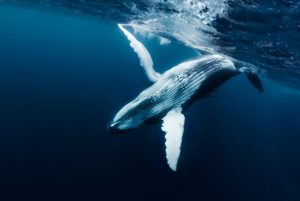 Surprising details about the transition of early whales from living on shore to diving down to feast on deep-dwelling prey have been revealed by Dr Sarah Dungan and Professor Belinda Chang of EEB and CSB. Their pivotal result shows that early whales had visual systems adapted to deep diving, firmly linking this change in behaviour to swift evolutionary adaptation.
Surprising details about the transition of early whales from living on shore to diving down to feast on deep-dwelling prey have been revealed by Dr Sarah Dungan and Professor Belinda Chang of EEB and CSB. Their pivotal result shows that early whales had visual systems adapted to deep diving, firmly linking this change in behaviour to swift evolutionary adaptation.
Deep diving by marine mammals is one of the great evolutionary transitions, along with powered flight and living on land, and reveals much about how quickly life can adapt in a changing world.
Whales evolved from mammals that share a common ancestor with hippos and that were partially aquatic. The great mystery of their transition to deep sea foraging was how quickly this ability developed. Dungan had an early fascination with transitional whale fossils, but it wasn’t until she took a course on molecular evolution from Professor Chang that she became inspired to extend her interest in whale fossils to the molecular level. They focused on the rhodopsin protein, which absorbs light and sends a signal that travels through the retina to the brain.
Dungan applied robust data science models to rhodopsin proteins from a variety of living whales and related mammals. This computerized analysis revealed a gene sequence representing the rhodopsin found in the common ancestor of all living whales. Dungan expressed this gene in lab-grown cells to ‘resurrect’ the predicted protein and experiment on purified samples.
Dungan and Chang were astonished by the biochemical properties of the resurrected protein compared to land mammals. Early whale rhodopsin was more sensitive to the blue light that penetrates deepest into the ocean, to a degree that exceeded expectations. Its biochemical properties also suggested that the retinas of early whales could respond rapidly to changes in light levels.
These results mean that the common ancestor of living whales was already a deep diver, able to see in the blue twilight zone of the ocean, with eyes that swiftly adjusted to dark conditions as the whale rushed down on a deep breath of surface air.
Early whales eventually evolved into the many kinds of toothed whales and baleen whales we see today. As separate species of whale evolved, they established ecological niches at various levels of the sea and even in freshwater rivers. Dungan and Chang’s work shows that there were further evolutionary adaptations as members of both groups either surfaced from the early deep levels to hunt closer to the surface or specialized to become even more extreme divers.
This work is published in the journal Proceedings of the National Academy of Sciences as “Ancient whale rhodopsin reconstructs dim-light vision over a major evolutionary transition: Implications for ancestral diving behavior”. Dungan and Chang now plan to resurrect the ancestral whale proteins that transmit the rhodopsin light signal from the retina to the brain to provide insights into the neurological adaptations associated with deep diving. As they probe ancient evolutionary adaptations associated with new behaviours, we will gain greater insight into how animals may adapt to our changing world.
